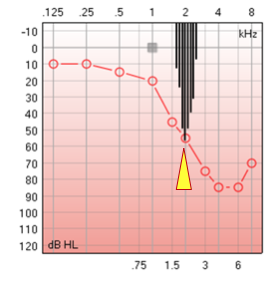Subscribe to the Interacoustics Academy newsletter for updates and priority access to online events
Training in Pure Tone Audiometry (PTA)
What is Pediatric Noise?
Description
It is simply a band of noise that is focused is a very narrow band of frequencies, with steep filter slopes, to produce a noise stimulus suitable for threshold estimation.
For example, this is a spectrum of a paediatric noise centred at 1000 Hz. Equivalent stimuli are available across the audiometric range, and are calibrated in dB HL.

These stimuli are useful in paediatric testing where a noise-like stimuli can sometimes be more “attention grabbing” and because in the soundfield (which is common for paediatric behavioural testing such as Visual Reinforcement Audiometry) the routinely used pure tones are not appropriate due to potential calibration errors (e.g. due to standing waves).
Please note that narrow band noise (1/3 Octave bandwidth) for threshold estimation is not appropriate as the frequency bandwidth is too wide to be considered acceptable, and steeply sloping losses might be underestimated due to off-frequency listening.
For example, below is an illustration of the paediatric noise stimuli centred at 2 kHz, overlaid on an audiogram showing a steeply sloping loss.
It may be seen that a wider bandwidth stimulus could be heard at lower frequencies (e.g. ≤ 1 kHz) where hearing sensitivity is relatively good, but the paediatric noise stimuli do not span this frequency range.

Presenter

Get priority access to training
Sign up to the Interacoustics Academy newsletter to be the first to hear about our latest updates and get priority access to our online events.
By signing up, I accept to receive newsletter e-mails from Interacoustics. I can withdraw my consent at any time by using the ‘unsubscribe’-function included in each e-mail.
Click here and read our privacy notice, if you want to know more about how we treat and protect your personal data.
